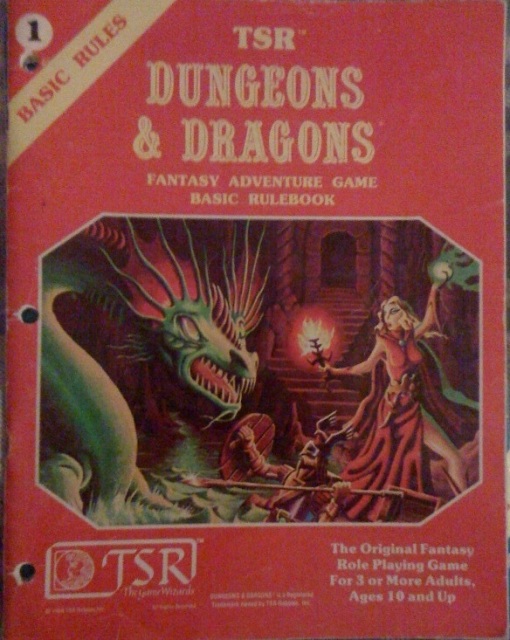 My introduction to D&D was in 5th grade on a snow day. Our next-door neighbor had gotten the D&D Basic Set for Christmas and no one could make head or tails of the rules. This was the Tom Moldvay version of the rules, pictured in this post.
My introduction to D&D was in 5th grade on a snow day. Our next-door neighbor had gotten the D&D Basic Set for Christmas and no one could make head or tails of the rules. This was the Tom Moldvay version of the rules, pictured in this post.
I managed to get my own copy of the rules and thought it was amazingly cool. It was hard as hell to understand, but it screamed geeky coolness. It was also a gateway for friendships with like minded geeks, something whic led to friendships with some people I’m still in touch with through the magic of Facebook nearly thirty years later. Excuse me while I stare at that number.
There’s something of an “Old School Renaissance” movement going on right now, rediscovering the history of fantasy gaming. A lot of it centers around the creation of “retroclones” – using the Open Gaming License (OGL), developed by Wizards of the Coast for the 3rd edition of D&D to allow for licensing of D&D rules and terms, to backport to older versions of the games. The ones I’m familiar with include:
- Swords & Wizardry – inspired by the original edition of the game that evolved from the fantasy wargame “Chainmail”. It is available in two versions, the main rules and the “white box” rules, which is a more stripped down version of the rules.
- Labyrinth Lord – inspired by the D&D Basic and Expert sets with add-ons to capture the feel of the original edition and AD&D (the latter forthcoming at the time of this writing).
- OSRIC (Old School Reference and Index Compilation) – Inspired by the 1st edition of AD&D, I believe this is the first of the retro-clones.
- Basic Fantasy Role-Playing Game – This one feels a bit like D&D Basic/Expert rules with features from AD&D and D&D 3e sneaking in.
These retro-clones have become more important to old-school gamers given that Wizards of the Coast, earlier this year, pulled all their pdf reprints from online shops like rpgnow.com. I think that’s unfortunate, especially regarding the older editions. I read one of their concerns was finding pirated pdfs of new books online. I can appreciate that concern, especially given the importance of getting the initial sales from a new book, but I’m not certain of what advantage it was pulling the older games. That said, the Tom Molvay version of the D&D Basic and Expert rules was never made available in any case.
Last night I was flipping through my copy of the Moldvay Basic rules (not my original, which vanished somewhere in various trips to college and moving to Massachusetts a few years after graduating from UConn). And that gave me the idea of doing a gradual review as I reread the rules in detail, trying to forget things I’ve taken for granted for years and years. It probably won’t become the main focus of this blog – I’ve got an active Wild Talents game that will probably consume a lot of my time. I’m also not a hardcore old-schooler – I like old and new games. I had a lot of fun playing D&D 4th edition – more fun than I did in the 3rd edition, which I also enjoyed.
—
So we’ll start our review with the Erol Otus cover. Erol Otus’s illustrations appeared in many of the classic D&D products of the 70s and 80s. In this cover you’ve got our heroes descending into a water-covered level of a dungeon to fight a green dragon – I’ve never understood why dungeons and dragons so rarely appear on the covers of Dungeons & Dragons products… Though I think we can give a pass for the original 1st edition AD&D covers, especially demon idol on the Players’ Handbook. The Basic Rules indicate it is for 3 or more adults, ages 10 and up – an odd definition of adults. I was 10 when I started playing and felt all mature and adult. Not from playing D&D, just from feeling all mature and adult at the age of 10. I believe this trend would continue until adulthood, upon which you discover how little you know.
The foreward starts off with Tom Moldvay talking about an encounter with a dragon to set the mood. He then talks a little about the history of the D&D rules – how they were originally designed for people with a background in gaming and of the numerous questions the TSR staff answered since its release. He does indicate how he’s tried to stay true to those earlier versions but make this set more understandable. Having obtained both the previous Basic rules (by Eric Holmes) and the original “white box” version of D&D I’d have to say, though this version was tough (but fun) for my ten-year old brain, it was a vast improvement in terms of comprehensibility.
—
And we’ll end with that. I think I’ll be able to cover more in future installments, but I wanted to also set the stage for what I was intending. Though I also intend on working my way further through the new Doctor Who game and work on my Wild Talents game. And some posts to my political blog, so this may take a while…












December 20, 2009 at 9:14 pm
[…] D&D Basic Rules Retrospective Part 1 […]